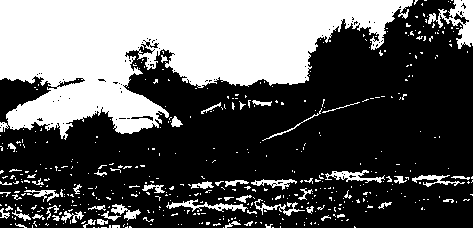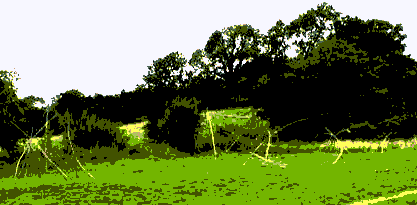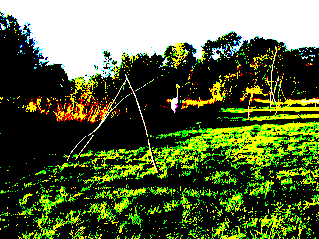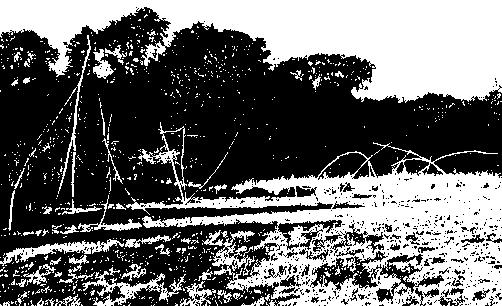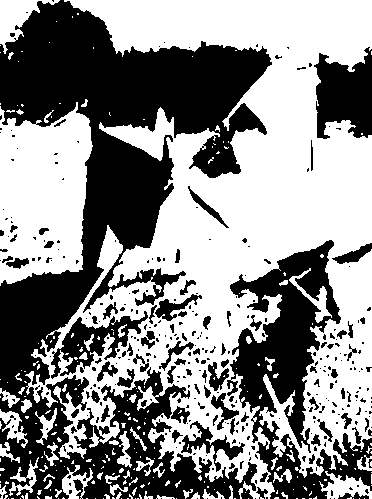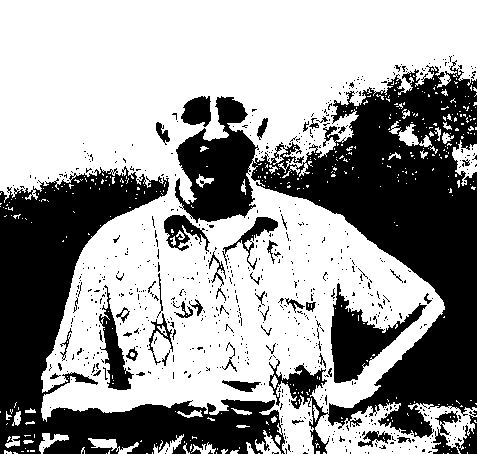Passages Camps - Bender Pole Sculptures, Summer 2004
Apart from with the first sulpture, all the names came after they had been built, so please feel free to see them as something else. When I was conceiving them it was the concepts of tension, compression, bending, suspension, floating, gravity, flying etc that were important, rather than representing other things.
Clicking on photos on this page will take you to normal colour versions (the versions on this page were originally done to create smaller file sizes - but I like them in their own right).
- Tetrahedron -
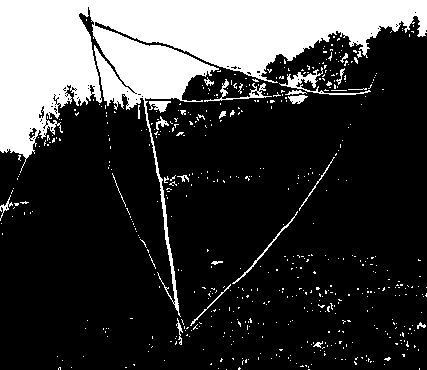
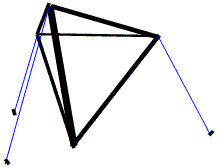 Tetrahedron was the first one I thought of, and the first I constructed. The idea came to me during a "Synapse" meeting. (This was intended to be a co-ordinating theme for art projects during the week - how my sculptures relate to this theme I do not know!) The theme that I had more in mind beforehand was to do with construction. I think there were also thoughts about science and engineering. Before these sculptures I had thought about extending the land-art type things that had been done around the spring. Then I had extended the shelter above around the fire - though this had to be taken down quite soon afterwards as it as a strong wind blew up and my extension threatened to blow away, and take the main structure with it!
Tetrahedron was the first one I thought of, and the first I constructed. The idea came to me during a "Synapse" meeting. (This was intended to be a co-ordinating theme for art projects during the week - how my sculptures relate to this theme I do not know!) The theme that I had more in mind beforehand was to do with construction. I think there were also thoughts about science and engineering. Before these sculptures I had thought about extending the land-art type things that had been done around the spring. Then I had extended the shelter above around the fire - though this had to be taken down quite soon afterwards as it as a strong wind blew up and my extension threatened to blow away, and take the main structure with it!
With Tetrahedron one of the things I was thinking was the Snowdon Aviary at London Zoo, where some of the frameworks that the netting is suspended from do not reach the ground, and are suspended by cables from other structures lower than themselves - that is, the highest parts of the suspended structures that do not rest on the ground are higher than the highest parts of the suspending structures that do rest on the ground.
Some links about the Snowdon aviary (1962-1964) by Lord Snowdon, Cedric Price and Frank Newby
I could not find any pictures of the details of construction.
(Another influence, that I only thought of later, was going to look at the BBC transmitter at Burghead the previous week. Some pictures found on the web: http://tx.mb21.co.uk/gallery/burghead.asp. I found it incredible to be standing so close to something that was pushing 50 thousand watts straight into the air and not feeling, hearing or seeing a thing.)
The feeling I was after was one of gravity-defying, flying or floating - like the logic of dreams where just taking off and flying suddenly becomes quite reasonable when one remembers how to do it (well that's how it often works in my dreams anyway).
The Tetrahedron was originally going to be one of 4 tetrahedra, with 3 on the ground and one off the ground and higher than the rest. I later thought of other variations which were simpler to achieve which achieved the essential idea I was after of this sort of almost paradoxical support.
There was also an issue of shortage of time, energy and materials.
Putting the Tetrahedron standing up on one corner was found sufficiently paradoxical by many people - especially if they had not yet spotted the thin guy ropes.
About size: I did not think of including anything in the photos to give the scale of the structures - they are mostly too tall for anyone to reach the top bits if reaching upwards.
Another interesting connection is that the pyramid shape (though possibly a square-based one), pointing upwards, has many connotations in "New Age" or alternative circles, so that also made it interesting to put a flat side at the top and a point at the bottom.
Getting Tetrahedron from standing on an edge to standing on a point is the only time I asked for help from anyone else while constructing - though I could probably have done it on my own taking more time at it.
- Curves -
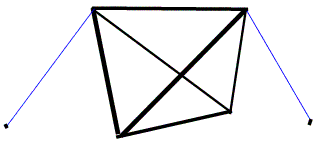 As a part-way stage to having it on a point I had it standing on one edge, and that made it seem almost like a completely different shape - a bit like a square becoming a diamond if rotated through 45 degrees. In some ways I found it more interesting in this configuration: interesting to walk through and also to see how it changed between a V-shape and a square with diagonals as one walked around - and I think some people might not have realised that it was just a pyramid another way round. I also left it standing this way for a while as part of the taking down process.
As a part-way stage to having it on a point I had it standing on one edge, and that made it seem almost like a completely different shape - a bit like a square becoming a diamond if rotated through 45 degrees. In some ways I found it more interesting in this configuration: interesting to walk through and also to see how it changed between a V-shape and a square with diagonals as one walked around - and I think some people might not have realised that it was just a pyramid another way round. I also left it standing this way for a while as part of the taking down process.
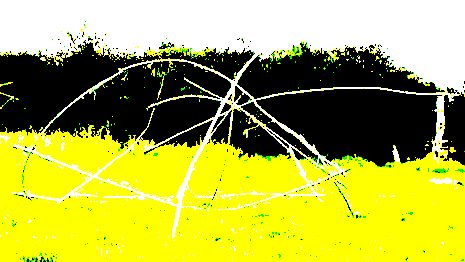 After the very regular and straight-sided Tetrahedron, I decided to go for something with curves. I first thought of making a ball that could be rolled about, but did not have enough sufficiently bendy bender poles. Then I tried making a dome shape and then turning it over. I achieved the dome but I had not made it sufficiently rigid, so it just flopped about a lot as I tried to turn it over, and it just looked like a failed sweat-lodge. Eventually I propped it up enough so that it did not look like a failed something else to me at least - though I did give it the provisional name of Collapsing Structure (gravity was definitely showing itself on this one rather than being overcome!) - I am now calling it Curves.
After the very regular and straight-sided Tetrahedron, I decided to go for something with curves. I first thought of making a ball that could be rolled about, but did not have enough sufficiently bendy bender poles. Then I tried making a dome shape and then turning it over. I achieved the dome but I had not made it sufficiently rigid, so it just flopped about a lot as I tried to turn it over, and it just looked like a failed sweat-lodge. Eventually I propped it up enough so that it did not look like a failed something else to me at least - though I did give it the provisional name of Collapsing Structure (gravity was definitely showing itself on this one rather than being overcome!) - I am now calling it Curves.
- Acrobats -
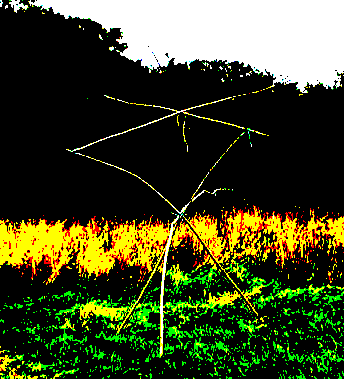
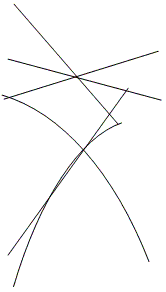 Next came Acrobats, which I thought of as a father and son balancing act.
Next came Acrobats, which I thought of as a father and son balancing act.
- Ballet -
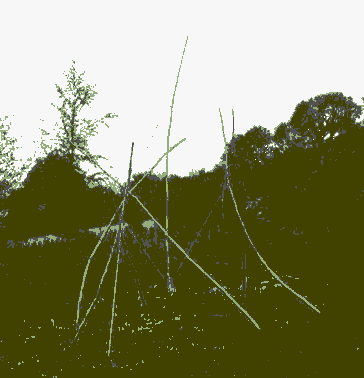 Fourth came Ballet, which is a simplification if what I was thinking of with the 4 tetrahedra mentioned earlier. The idea of it being a central ballerina being lifted up by 3 ballet dancers came from someone else after I had built it. Note that the central "ballerina" does not rest on the ground, and also rises above the parts of the structure that do. The point at the feet of the ballerina where there are guy ropes pulling upwards feels very crucial to me.
Fourth came Ballet, which is a simplification if what I was thinking of with the 4 tetrahedra mentioned earlier. The idea of it being a central ballerina being lifted up by 3 ballet dancers came from someone else after I had built it. Note that the central "ballerina" does not rest on the ground, and also rises above the parts of the structure that do. The point at the feet of the ballerina where there are guy ropes pulling upwards feels very crucial to me.
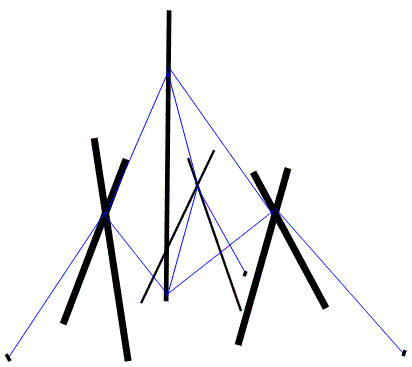 What was also exciting was whether it was going to stand up as I imaged it, and how was I going to get it up there on my own as it was a lot taller than me, and some of the points where strings are tied to wood end up out of my reach in the final form. I deliberately decided not to ask anyone to help, or use anything to stand on, as this felt like part of the interest - like an engineering project where you are trying to build something taller than any cranes available.
What was also exciting was whether it was going to stand up as I imaged it, and how was I going to get it up there on my own as it was a lot taller than me, and some of the points where strings are tied to wood end up out of my reach in the final form. I deliberately decided not to ask anyone to help, or use anything to stand on, as this felt like part of the interest - like an engineering project where you are trying to build something taller than any cranes available.
As it turned out I needed to put in some extra bits of string while I was putting it up and that I later removed. Part of what I wanted to achieve was the use of minimal supports. Ballet has 3 guy ropes fixed to pegs in the ground, 6 other lengths of string, 6 poles touching the ground, and one pole not touching the ground.
One way I liked to look at Ballet was to lie on my back with my eyes directly below the central pole looking up along the what then looks like most of a tree. I think making this structure with the central part being fairly substantial tree, roots and all; looking at it up from below would be really interesting.
- Dino -

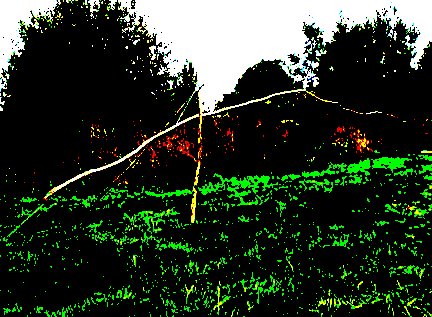 With Ballet I had thought I had reached a minimal structure, but then I realised I could go further - Dino only pulls at the ground in one place and pushes at the ground in 2! And the pushing and pulling on the ground bits are 2 parts not tied directly wood-to-wood - and are only attached together by one piece length of string!
With Ballet I had thought I had reached a minimal structure, but then I realised I could go further - Dino only pulls at the ground in one place and pushes at the ground in 2! And the pushing and pulling on the ground bits are 2 parts not tied directly wood-to-wood - and are only attached together by one piece length of string!
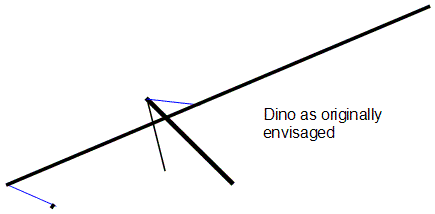 Dino did not work quite like I imagined it - my original design had things leaning and pulling in different directions than in the final version and - when I tried to do it like I imagined it, it just twisted and either fell over or had bits leaning against each other that I did not want.
Dino did not work quite like I imagined it - my original design had things leaning and pulling in different directions than in the final version and - when I tried to do it like I imagined it, it just twisted and either fell over or had bits leaning against each other that I did not want.
I was amazed by the amount of energy Dino had - it really seemed to be straining to get away. It made me think of Henry V "I see you stand like greyhounds in the slips, Straining upon the start". The energy and tension in the structure also showed in the particular way it oscillated when given a push.
It also regularly fell down either the poles slipping against the ground or the strings snapping. Someone said it looked like a brontosaurus (the long neck); I thought it more like a tyranosaurus, urging forwards on 2 legs; - hence dinosaur or Dino. I was a bit disappointed in one aspect of this structure - I could really get the bit not touching the ground to go (much) higher than the bit that was - partly due to the wood being curved - but this was more than made up for by how much more exciting it was than I expected - and the lower it crouched over the ground the more exciting it felt.
At this point someone said that they thought that each structure had progressively more energy than the one before. I agreed. I was also thinking about becoming more minimal in achieving in the criteria of: at least 2 separate parts to the structure (that is, not tied together with wood touching wood); only one part touching the ground and the other part being higher; minimal bits of string, especially ones tied to the ground.
- Lampost -
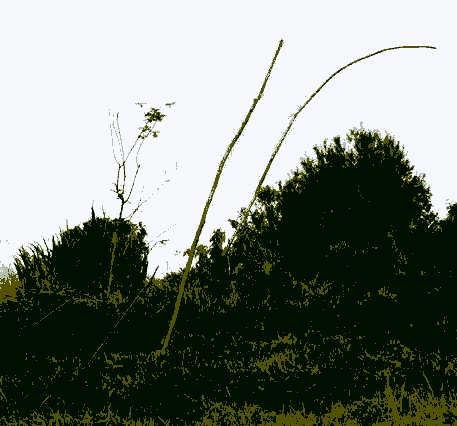 The final structure, Lampost, only has 2 bits of wood and only one place of pressing on the ground, but 3 guy ropes attached to the ground; so both Lampost and Dino are the most minimal in different ways. Lampost felt like it was lower energy than Dino. The name comes from my feeling that it is just asking for a lamp to be suspended from it.
The final structure, Lampost, only has 2 bits of wood and only one place of pressing on the ground, but 3 guy ropes attached to the ground; so both Lampost and Dino are the most minimal in different ways. Lampost felt like it was lower energy than Dino. The name comes from my feeling that it is just asking for a lamp to be suspended from it.
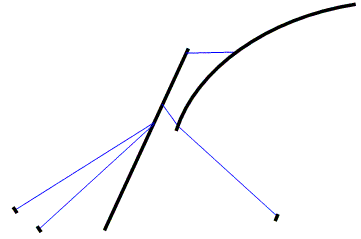
When I had had completed and photographed them all in their "pure" forms, I laid them open to what other people wanted to do with them, which included attaching lanterns to them for the "Ceremony".
A couple of group photos:
A couple of photos taken when some lanterns had been attached:
In this second one with lanterns, the "Shepton Suspension Bridge" and the (dark green) sedan chair can be seen in the background (if you go to the normal colour version) - (see description of this year's Ceremony):
This one was not intended to be a sculpture, just somewhere to hang my washing:
And finally I let someone else (mostly) take them down.
Me watching Barry demonstrate the camera he lent me to take the pictures:
3D: Links to stereo pairs of pictures for cross-eyed or spread-eyed viewing, and made into animations to give a 3D effect..
About the materials:
- Bender poles of various lengths and tendencies to bend or snap. The fact that they were not straight or rigid added life to the sculptures. Also, if one is constructing a precisely-defined geometrical shape like a regular tetrahedron, then no matter how straight and thin one's lines are, they are always an approximation the abstract lines which are perfectly thin and straight - so one might as well use thick and bent bender poles.
- Blue "poly" (polyethylene?) string: not very "natural" but is what most of the bender structures are tied together with and so reflects this. And I just happened to have some that had been going cheap.
- Metal tent pegs (presumably) abandoned by previous campers, and wooden ones fashioned myself.
About benders, wigwams and teepees:
For those who do not already know "benders" are structures made from young bent wood and with canvas covers. And I also found out recently, these are basically what native americans call "wigwams" (though they probably, at least originally, used a different type of covering). I had thought previously that wigwam was just a politically-incorrect name for a teepee. So, wigwams are dome shaped and teepees are conical.
Doing a bit of research on the web, teepee/tipi and wigwam tend to be used interchangeably but on this page I found a reference to "correct" usage: http://www.agilitynut.com/wigwams.html
I cannot find anything about why the term wigwam should be considered politically incorrect - or even explicitly that it is considered as such.
Putting "wigwam" in Google brings up amongst the sponsored links 2 organisations that that do tipis, yurts and similar but I can find no use of the word wigwam on their websites - this indicates to me a reluctance to use the word, even though they must have specified it as a "search word".
My guess about the origins of the political incorrectness is a combination of it being used in politically incorrect "cowboys and indians" films, and the fact that in these films it was used incorrectly to refer to conical structures.
Description of wigwam: http://www.mnsu.edu/emuseum/prehistory/settlements/regions/east_and_southeast.html
Sculptures, photos, diagrams, description by Frank Sierowski, August 2004
